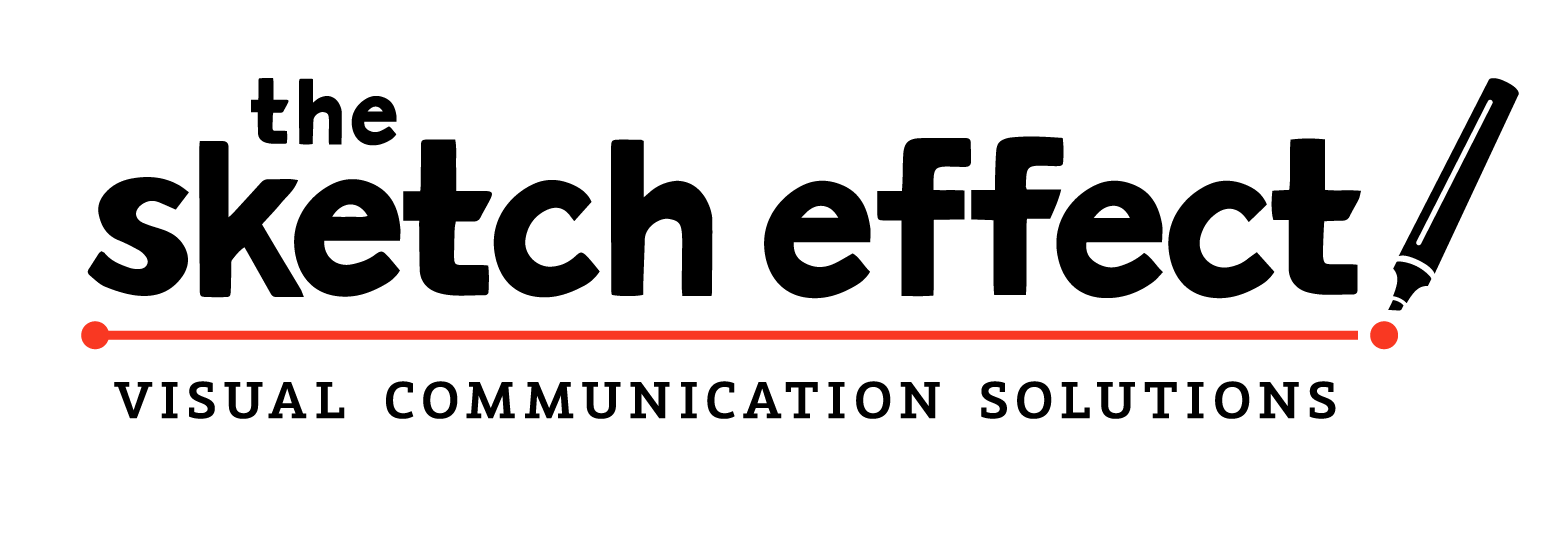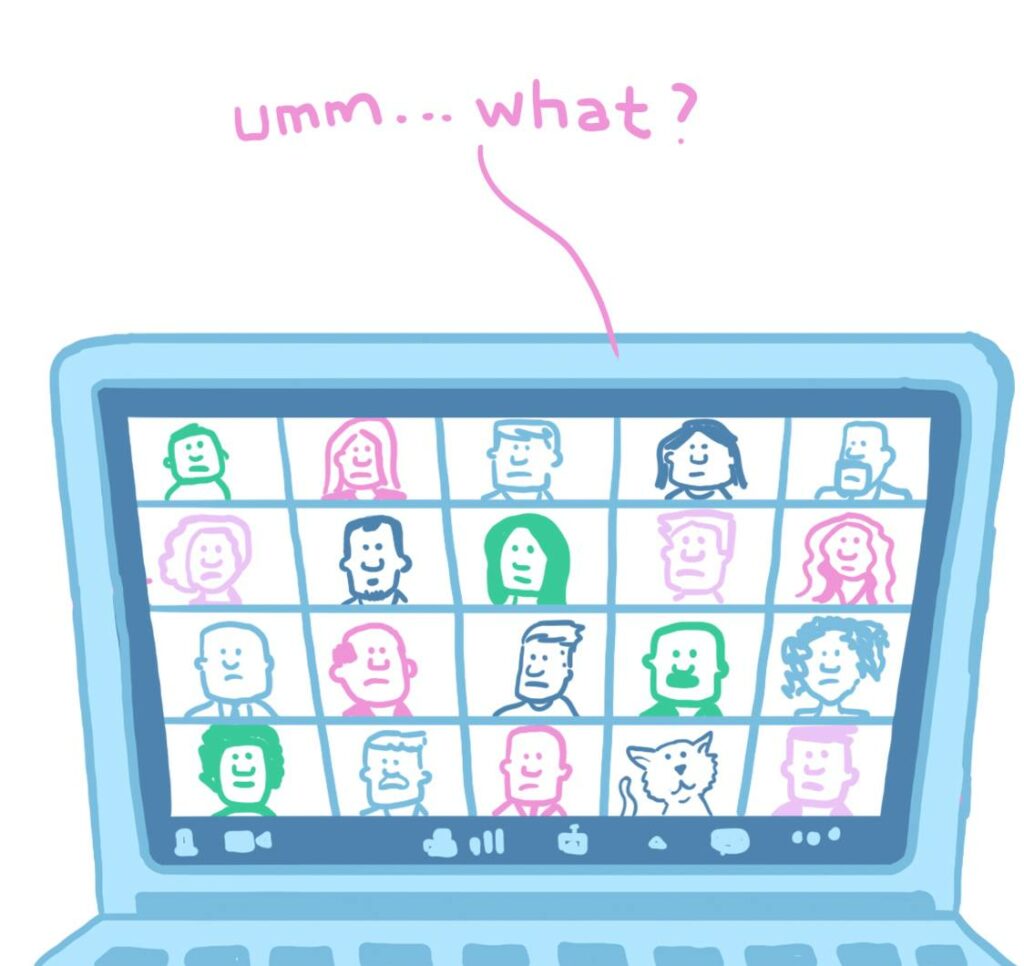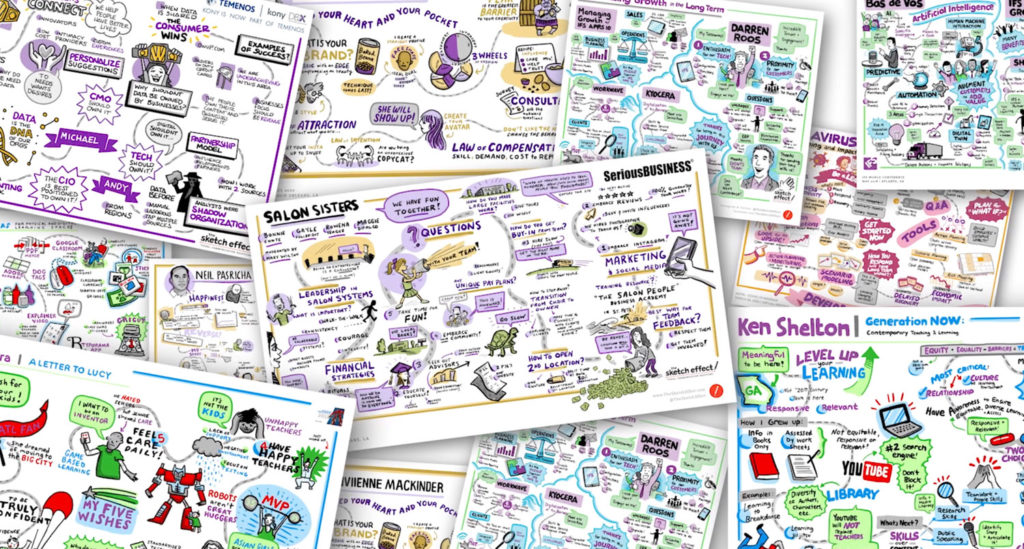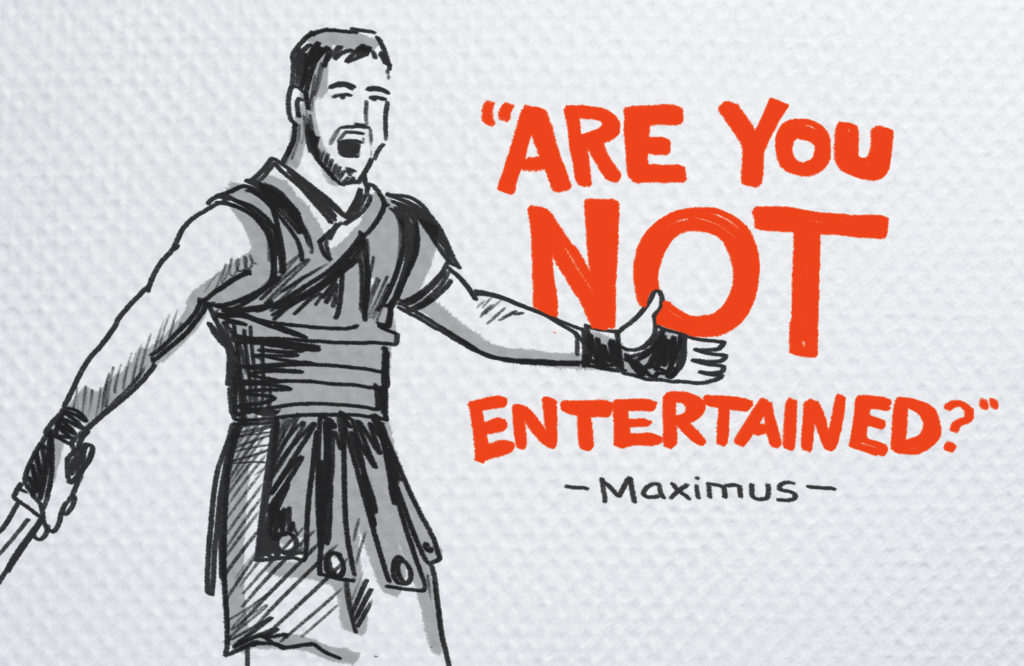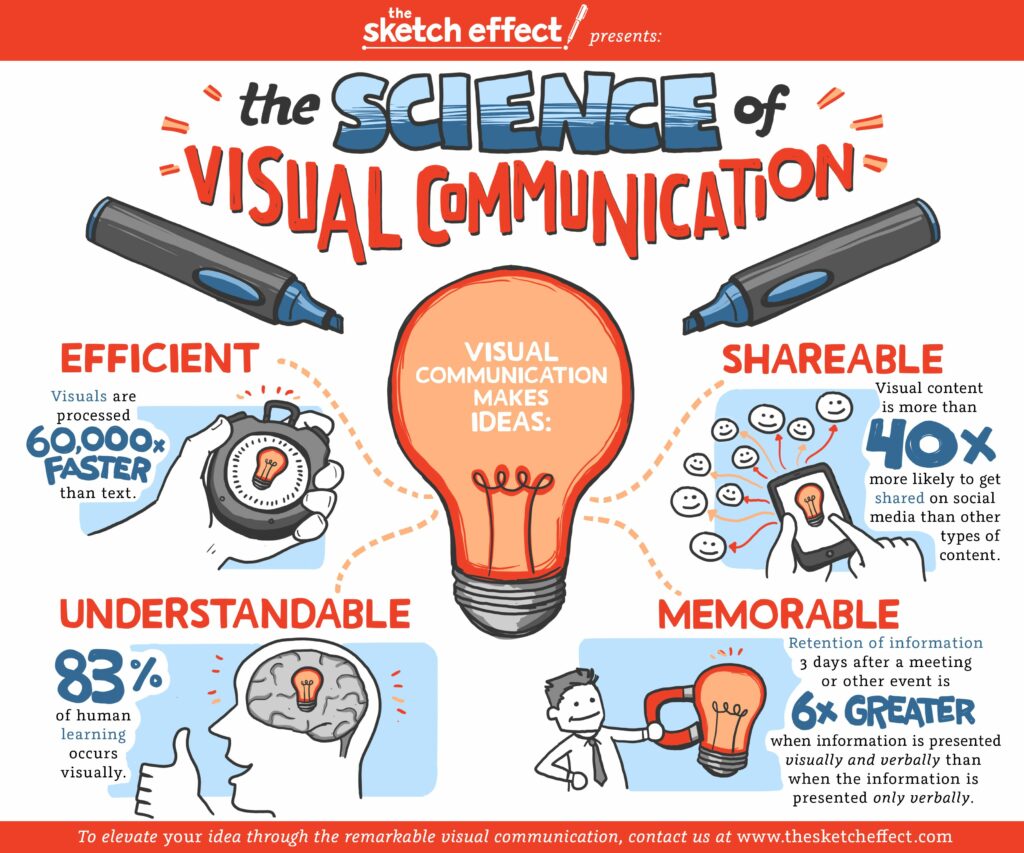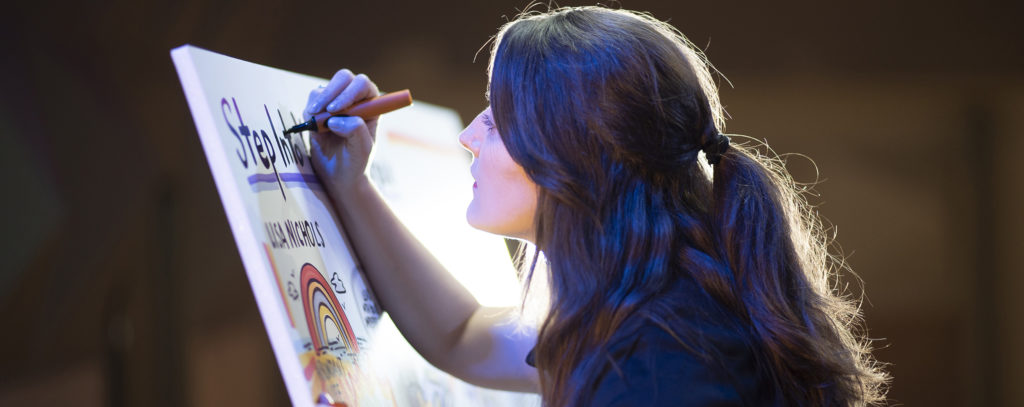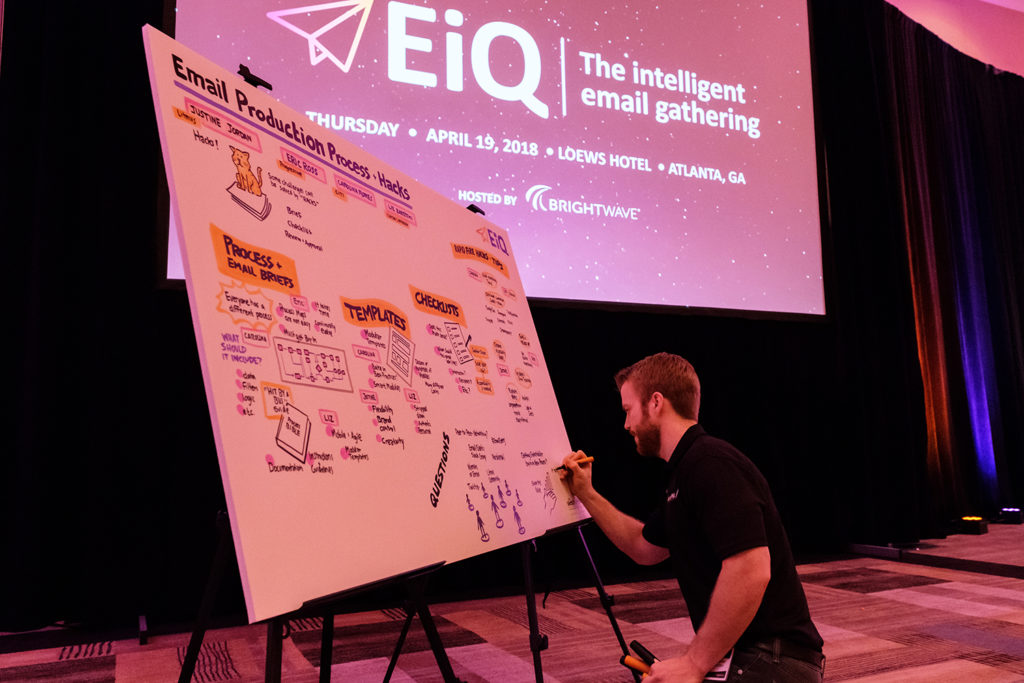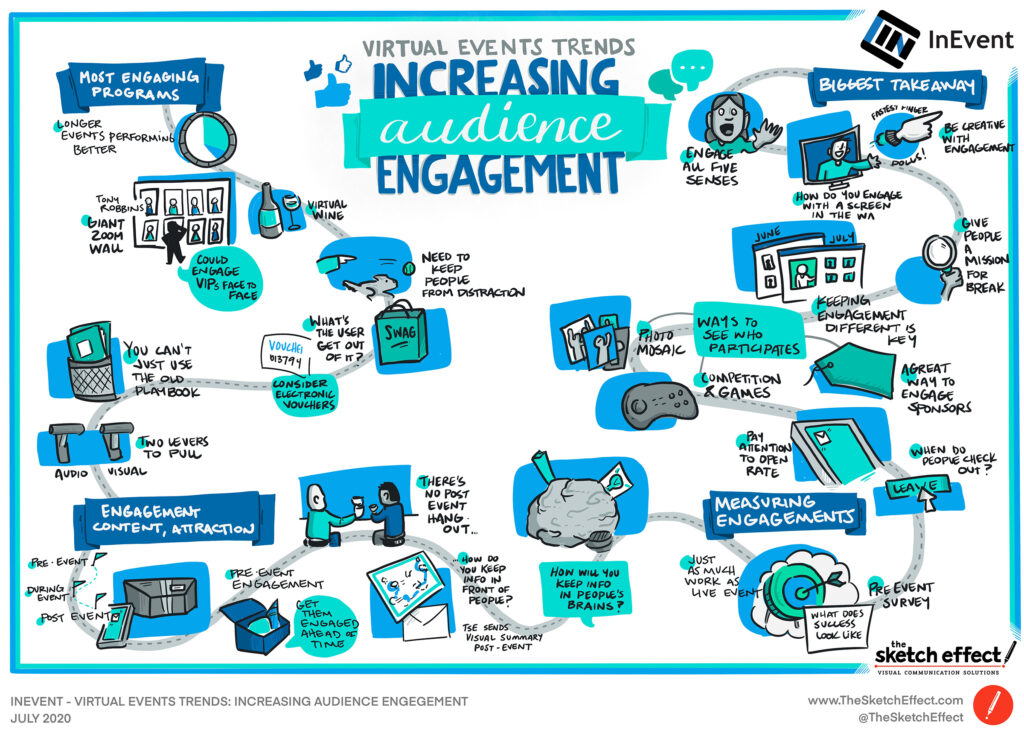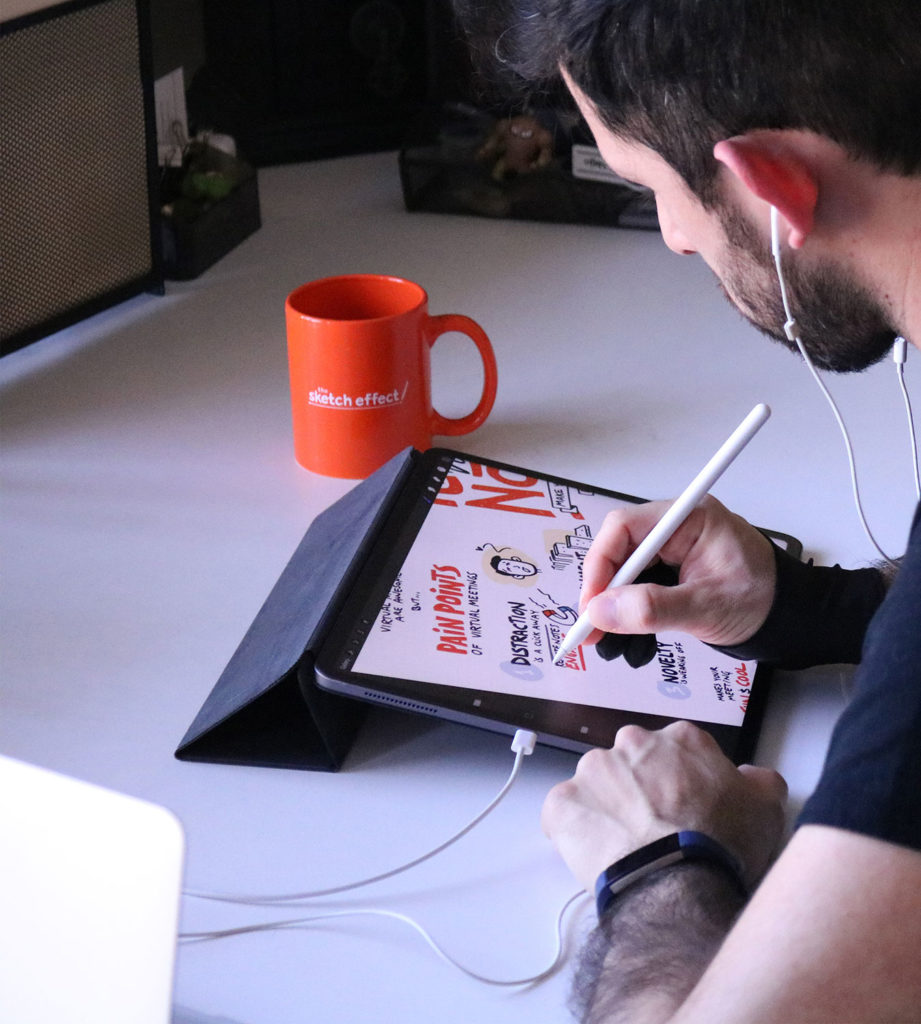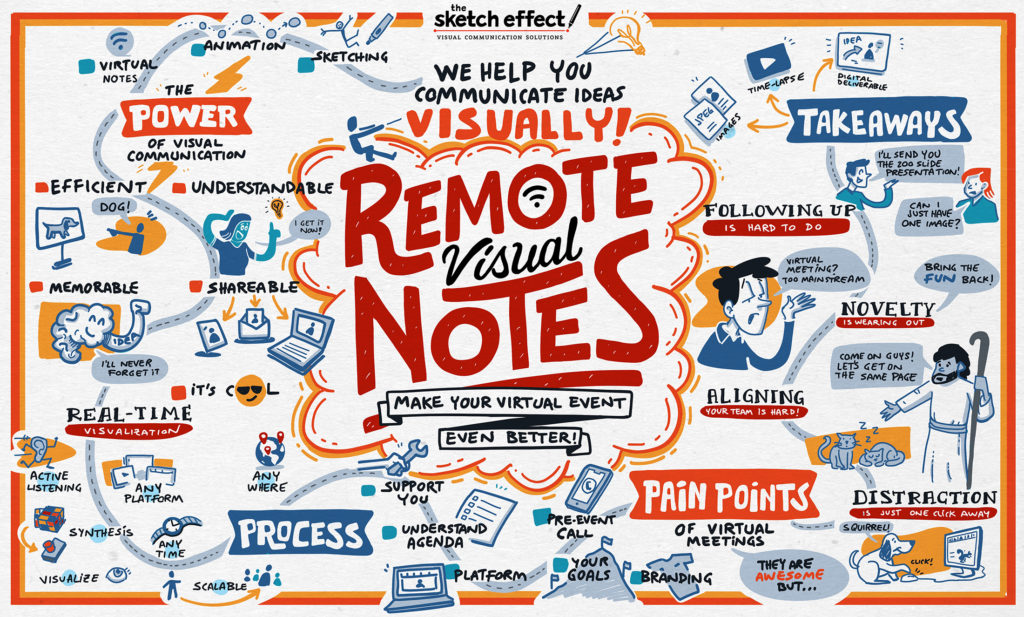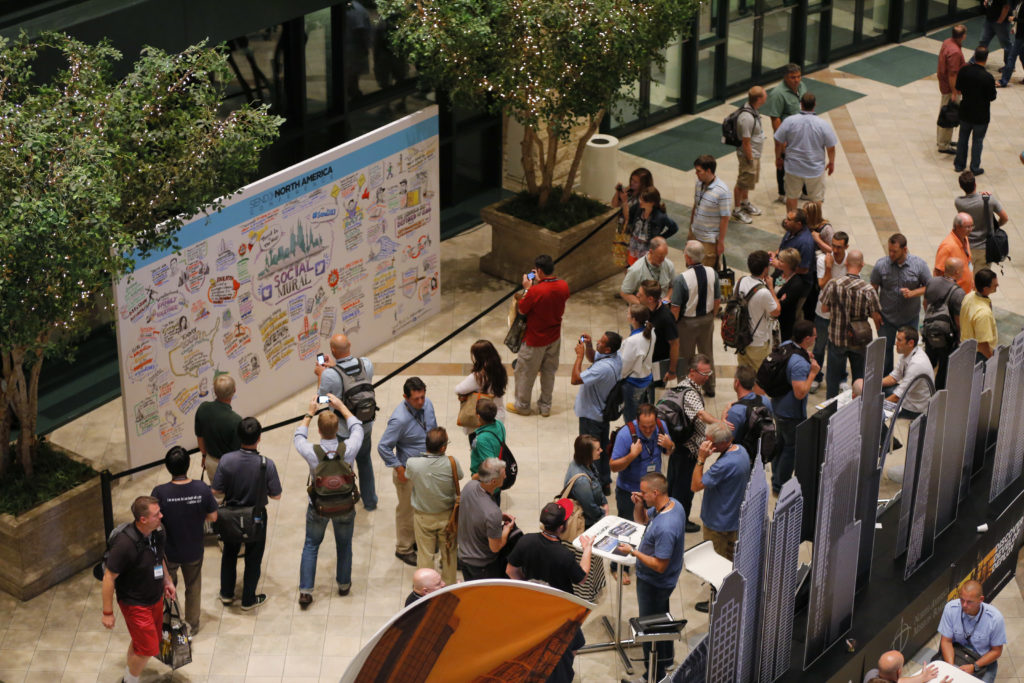Why Virtual Live Sketching?
In the wake of COVID-19 and the seismic impact the pandemic has had on live events, everyone has scrambled to convert their in-person meetings, conferences, and events to a virtual context.
Instead of a glitzy ballroom in Vegas, we are now on Zoom.
Instead of a corporate retreat center deep in the Appalachian Mountains, we are now on Microsoft Teams.
Instead of a massive arena in downtown Los Angeles, we are logging onto GoToMeeting.
Instead of a conference room in the snazzy Manhattan corporate office, we are now dialing into Google Meet.
You get the picture.
Although we are all grateful to live in a day and age with a virtual alternative to in-person gatherings, one unfortunate truth remains:
Most virtual events are terrible.
Boring. Blah. Lame. Mundane. Meh. Rote.
Whatever word you choose, most of us have had our fill of virtual events.
The good news is that there are lots of enterprising companies and teams out there striving hard to innovate ways to make virtual events better and introduce compelling solutions to address the pain points of these online gatherings.
One of those innovative solutions is Virtual Live Sketching (aka “Remote Visual Notes”).
Although Virtual Live Sketching isn’t entirely new, the scale to which it is being leveraged in the wake of COVID-19 was unheard of until now. Although the tools and mechanisms for delivering this remote visual note-taking service were already in existence, the way companies, teams, and organizations are harnessing it to deliver value to their audiences is taking us into uncharted territory.
Virtual live sketching is a compelling, engaging, and must-have value-add for virtual meetings and events in a post-COVID world, and we’ll share with you just why.
In this Definitive Guide to Virtual Live Sketching for Meetings and Events, you’ll learn about:
- The history of visual communication. From cavemen to memes, we’ll explore how visual learning and communicating with simple pictures is hard-wired into our DNA.
- The power of visual communication. Using actual data and research, we’ll unpack the four main ways that visuals supercharge communication to make it more effective.
- Live sketching overview. Whether you call it live sketching, visual notetaking, graphic recording, doodling, live scribing, or sketchnotes, we’ll give a quick overview of this particularly exciting form of visual communication and collaboration.
- Contexts for live sketching. There are dozens of ideal contexts for live sketching – we’ll explore the top ten places where you may find this service in action.
- COVID-19 and the dawn of remote visual notes (aka virtual live sketching). In 2020, the world of live sketching changed forever. We’ll show you how.
- Virtual live sketching overview. With the “dawn” of virtual events, many aspects of live sketching have changed. Many have not. We’ll take a moment to walk through how remote visual notes works, the tools used, common platforms for integrating it into virtual events, and our process.
- What makes virtual live sketching awesome. There are four huge pain points when it comes to virtual events and four huge ways that remote visual notes tackle these pain points head-on. The net result: better virtual meetings and events.
- Leveraging the sketch output. When it comes to maximizing the value of the sketch output and deliverables, the possibilities are endless. We’ll take a look at some of the most common ways these compelling takeaways are leveraged.
- What can you do? We’ll conclude with some actionable next steps to begin leveraging virtual live sketching for your next virtual meeting or event.
History of Visual Communication
Before we get into the “here and now” of Virtual Live Sketching and Visual Communication, let’s talk about the history of visual communication. Don’t worry, we’ll promise not to bore you.
The first forms of visual communication popped up between 40,000 and 8,000 BC. Of course, we’re talking about prehistoric cave paintings. Most scholars agree that these paintings were used for ceremonial purposes, to bond a tribe together and celebrate communal efforts, like a great hunt or battle. In brief, they were simple pictures to communicate ideas, align a group, and inspire action.
From there, the next major form of visual communication was Egyptian Hieroglyphics, which emerged around 10,000 BC. These were simple images and icons used to tell stories. Another name for this form of visual communication is “petroglyphs.”
Visual communication took another leap forward around 2,000 BC, when the Chinese developed logograms, which we similar to hieroglyphics yet a bit simpler. Like their Egyptian predecessor, logograms were simple symbols used to represent ideas, objects, people, or religious deities.
Between 2,000 and 700 BC, the Egyptians, Greeks and Romans introduced the idea of the alphabet: for the first time in human history, a simple symbol was used to represent a sound. These alphabets would go on to become the foundation of all modern languages.
Between 400 AD and 1600 AD visual communication became a primary feature in medieval Christendom. Illuminated manuscripts and stained-glass windows leveraged images, illustrations, icons and symbols to communicate the stories of the Bible. The reason for this is simple: most people at that time couldn’t read. In contrast, images were quick to understand, they were enjoyable to look at, they elicited emotion and they inspired people to action.
As technology advanced, so did visual communication. The advent of the printing press, photography, film, the computer and the internet all rapidly advanced the evolution of visual communication.
And so, where is visual communication today?
Emojis, Memes, and Gifs. Oh my.
Just kidding! Of course, emojis, memes, and gifs are all a form of visual communication, but that is not the point of this blog, or the point of this quick history lesson.
The point is simple: visual communication is in our DNA. It’s part of being a human. It makes communicating ideas easier and more effective. It excites, aligns, and inspires people. It leads to action and outcomes.
Visual communication is powerful, and that is why Live Sketching exists.
Power of Visual Communication
Yes, Live Sketching exists for one simple reason: Visual Communication is incredibly powerful. Visual Communication (and by extension, visual learning) is a powerful, effective and actionable way to share ideas, communicate a message, mobilize a team, inspire an audience, and drive real results.
So, how exactly is visual communication so powerful? There are four main reasons, all of which are backed up by science and research:
-
First of all, Visual Communication makes ideas efficient.
The old adage goes: “a picture is worth a thousand words.” We would argue it is worth far more than that! The research shows that 93% of communication is non-verbal, and that the human brain processes visuals at an unfathomably higher rate than it processes text. Another bit of research states that visuals are processed 60,000x faster than text. That is astounding.
Moreover, visuals are a global language that transcends linguistic barriers and most cultural barriers as well. Fewer people get tripped up on images, especially when compared to the written or spoken word, which can lead to misunderstandings and miscommunications.
In the Back of the Napkin, Dan Roam articulates this effectively:
“Pictures can represent complex concepts and summarize vast sets of information in ways that are easy for us to see and understand…they are useful for clarifying and resolving problems of all sorts.”
If you want to communicate ideas quickly, communicating with visuals is a no-brainer.
-
Second, Visual Communication makes ideas understandable.
Again, the science here is astounding. Listen this: 83% of human learning occurs visually. That means that the other channels of learning (verbal, auditory and kinesthetic) only comprise a mere 17% percent of human learning!
In fact, a study showed that people following directions with text and illustrations do 323% better than people following directions without illustrations. And sometimes, if you’re building an IKEA bookcase, your directions might not have text at all!
The truth is, visuals help you “see” the meaning behind ideas. They help make complex ideas and subjects understandable and powerful by making them visible.
Moreover, the average person’s attention span is incredibly short…and getting shorter. According to the research, the average human gets distracted in 8 seconds. This is a shorter attention span than a goldfish! Visual Communication also enhances comprehension simply by the fact that is holds peoples’ attention longer.
-
Thirdly, Visual Communication makes ideas memorable.
Again, the research backs this up. One compelling stat is that people remember 10% of what they hear, 20% of what they read, and 80% of what they see and do.
Another bit of research shows that retention of information three days after a meeting or other event is six times greater when information is presented visually and verbally than when the information is presented only verbally.
For whatever reason, pictures get lodged in our brains much more than spoken or written text. We forget names, but remember faces. Like experiences, we have a hard time forgetting powerful images and the ideas or concepts they embody.
-
Fourth and finally, visual communication makes ideas shareable and actionable.
It’s pretty simple—pictures are easier (and more fun!) to show to others. The outrageous growth of visuals-based social media platforms over the past few years testifies to this. Pinterest, Snapshot, Tumblr, Instagram and TikTok are all visuals-based social media channels…and they are growing like wildfire. People love to share and consume visual content.
Consider that Visual content is more than 40X more likely to get shared on social media than other types of content. Also, articles with an image once every 75-100 words got 2x the number of social shares than articles with fewer images.
To elaborate on this, a recent study showed that:
- Tweets with images received 150% more retweets than tweets lacking images
- Facebook posts with images receive 3X more engagement than those lacking images
- On Instagram, photos showing faces get 38% more likes than photos without faces
- Infographics are liked and shared on social media 3X more than any other type of content
Moreover, considering their ease of use and mainstream availability, anyone with a smartphone, whiteboard, or sketchbook can share their ideas visually. It has never been easier, cheaper, or more convenient to share and process visual content.
Visual communication is incredibly powerful and engaging…and not just on social media and in text messages. The principles of visual communication—and the value of it—applies to professional and business contexts as well.
To quickly summarize, visual communication is incredibly powerful. It helps make communication of ideas more:
- Efficient
- Understandable
- Memorable
- And Shareable and Actionable
Live Sketching helps you and others harness the power of visual communication and apply that power to engage an audience, align a team, and inspire action.
Let’s take a moment now to unpack just what we mean by “Live Sketching.”
What is Live Sketching?
Live Sketching goes by a lot of names: Graphic recording, visual notetaking, sketchnoting, live scribing, and the list continues. We use a lot of these terms interchangeably, although prefer “live sketching” as it’s the most understandable and approachable.
Whatever you call it, live sketching can be defined as “the real-time capture of content using sketched text and images”. Let’s break that definition down starting with “content.”
Most often the content that is captured in a graphic recording is spoken content, such as from a presentation, panel discussion, group discussion or team brainstorm. Whenever people get together to discuss ideas, those ideas can be captured in a live sketched format. However, sometimes other forms of delivered content can be sketched out, such as written group responses to a prompt or question, group emotions, or experiences as they are happening.
The fact that live sketching is in real-time is also important. Graphic recording is not a planned-out endeavor. It is not the same as a produced infographic or art directed illustration. Although portions of it may be planned out, such as layout, color, and a few key ideas, the vast majority of the sketch is organic and unscripted. It is done in real-time and strives to be an accurate and unbiased reflection of the content at hand.
Sketched text and images is the last part of the definition. This is the “what” of Live Sketching. Ideas are captured in both verbal and visual form. The text is mostly used to anchor the ideas to the page, and should never be overly verbose or lengthy. Just enough text should be captured to establish the core idea. Beyond the actual content of the text, the text can also be depicted in an expressive font or color, making the piece more dynamic and helping reinforce the nature of the ideas. The images can be whatever the live artist needs in order to reinforce the ideas on the page. These can include icons, symbols, human expressions and actions, scenes, and much more. At the end of the day, the text and images combined serve the sole purpose of making the ideas understandable, memorable, shareable and actionable. It is about harnessing the power of visual learning to give the content more life.
The first, and most critical step, when it comes to live sketching is Active Listening. Since the vast majority of graphic recording engagements take place in a context with a speaker or multiple speaking participants, the graphic recorder must be a great listener. If not, he or she will capture inaccurate content or miss critical content, both of which will negatively impact the process and final sketches.
At the Sketch Effect, all of our live artists are trained in active listening. As content is being discussed, they will dial up their listening abilities and hunt for the most critical takeaways, overarching themes, and recurring concepts. Active listening isn’t about capturing each and every word. Rather, it’s about capturing the big rocks. It’s about clearing away the “clutter” of a conversation to unearth the gems.
The second step of Live Sketching is the synthesis. As a live artist is actively listening, he or she will take it one step further and begin to synthesize. In other words, they will distill the ideas down to their purest essence. Again, it isn’t about getting down every idea possible. It’s about getting the most critical ideas. This is synthesis.
The third step of Live Sketching is usually text capture. This is when the live artist writes down words. Think of the words like the “bones” of a graphic recording. The words are the foundation of the sketch and inform what is illustrated around it. Again, the words should not be lengthy sentences or heavy prose. Rather, they should be pithy and to the point, capturing the idea with few but deliberate and powerful words.
Step four is the fun part: the sketching! In this step, the live artist breathes life into the bones and begins visualizing the ideas. This is when they add drawings, illustrations, color, icons and other imagery, all with the purpose of reinforcing the ideas and making the content more understandable and memorable. The sketches also serve a bonus purpose: they’re awesome! They are attention grabbing and eye-popping, adding a “wow factor” to any meeting or event in which they’re featured.
A key aspect of the drawings is the visual concepts. The concept is the “idea” behind the drawing. Some concepts are straightforward, like representing the idea of “growth” with an upwards and to-the-right arrow. Other concepts are cleverer, such as representing “teamwork” as a group of trapeze artists swinging through the air with interlinked arms. Some concepts can even connect back to pop culture, like depicting the idea of “pivoting” with a drawing of Ross, Rachel and Chandler moving a couch up a narrow stairwell. You get the idea. The illustrations on a graphic recording must have a great concept at their core. Otherwise, they are just nice-looking drawings and nothing more.
In addition to the actual drawings, the live artist will also add plentiful color to his or her sketch. Color can be used to reinforce concepts, establish themes, and categorize, along with establishing visual hierarchy and visual navigation. Color also makes the drawings look better, which is always a plus.
To summarize, we define Live Sketching as “the real-time capture of content using sketched text and images”, the goal of which is to reinforce ideas by making them understandable, memorable, shareable and actionable.
Let’s now unpack a few of the main contexts in which Live Sketching can add so much value.
Contexts for Live Sketching
One of the amazing aspect of live sketching is the wide range of contexts in which it can be leveraged to add value. In brief, anytime people are gathered together (in person or virtually) and are discussing ideas or solving problems, live sketching can make the experience better and more effective. Although there are endless types of engagements such as these that can benefit from a graphic recording artist, here are the most common:
- Company Events – The most straightforward scenario for live sketching is at a company event. This could be an all-hands meeting, a new year kickoff, a board meeting, a team summit, and much more. The content that is captured could be a big presentation by the CEO or other key leaders, an engaging panel discussion, or a keynote from an outside thought leader or industry expert. Whatever the company event, Graphic Recording can help document the content through real-time visualization of the big ideas and main themes.
- Corporate Retreats – Similarly, a corporate retreat or offsite event is another great context for live sketching. These retreats usually cover a LOT of ground, and there’s no better way to document the progress made than through live sketched Graphic Recordings. Retreat attendees can literally see all that they discussed in pictorial form, which is an amazing way to galvanize participants and energize them when they return to the office.
- Conferences – A public or internal conference is an ideal setting for live sketching. Most conferences will invest heavily in amazing speakers, organize thoughtful breakout sessions, and bring amazing experiences to their attendees. What better way to crystalize the ideas and experiences at a conference than with live sketched visuals.
- Brainstorm Sessions – A brainstorm session, where a small group of people meet to brainstorm and work through something big, is a perfect context for a live artist. As ideas are being thrown about, solutions are being teased out, and discoveries are arrived at, the live artist will actively listen and document what unfolds. It is a great way to ensure everyone is on the same page, that they can “see” their discussion, and that they drive forward towards the stated goal of that session, whatever it may be.
- Training Events – Any type of event where people are gathered for training is also a good opportunity to leverage a Graphic Recording artist. The artist will be able to observe the training and capture the key themes and critical ideas that emerge. Trainees will be able to walk away with an amazing visual piece that anchors the most important portions of the training.
- Team Workshops – Similar to training events, any team workshop can be enhanced with live sketching. The live sketch artist will watch the workshop unfold, capturing the most salient moments, key learnings and important takeaways. Workshop participants will see the output of their workshop visualized in the output of the live artist.
- Trade Shows – A trade show is prime opportunity to leverage live sketching. What better way to draw an audience into a booth than with a live artist. At a trade show, the live artist can capture aspects of the product, company or brand, interact with booth participants, or capture the key ideas from a presentation.
- Product Demos – A clever way to add flavor to a product demo is with a live sketch of the demo itself. This is an engaging addition that keep people’s attention.
- Sales Pitches – An interesting addition to a sales pitch is to incorporate live sketching as part of the pitch. This is a surefire way to make an impression and help the pitch resonate.
- Fundraisers, Auctions and Galas – Finally, charity events like fundraisers, auctions or galas are a great opportunity to incorporate live sketching. Typically, these events will feature presentations, stories, testimonials, and more, and capturing this content in the form of live sketched visuals will help the audience connect to the purpose of the event and stay engaged.
These are just a few examples of the many kinds of contexts in which live sketching can be best utilized. At the end of the day, the goal is to make these meetings, conferences, and events better. The purpose is to add value by making the content of these events understandable, memorable, shareable and actionable…and to “wow” people in the process.
COVID-19 and the Dawn of Virtual Graphic Recording/Remote Notes
As one can imagine, the COVID-19 pandemic completely disrupted world of live sketching. In a matter of weeks, every live event was completely cancelled and graphic recorders and live artists all over the world realized the severity of what was happening to their profession. What was bound to be a busy, productive spring began to look hopelessly bleak.
Thankfully, there was innovation to be done and pivots to be made.
The Sketch Effect was at the forefront of this “great pivot”, jumping immediately to retool live sketching and adapt it to a post COVID world. The result: “Remote Notes” …aka Virtual Live Sketching. This brand-new service was about to take the virtual world by storm and add immense value to the “new normal” of online events, webinars, and webcasts.
Ok, we are going to let you in on a little secret: “Remote Notes” was actually not a brand-new service. In fact, The Sketch Effect, and many others in the industry, had been offering a virtual version of live sketching for years, although this was always a peripheral offering. It always played a very second fiddle to the “OG” service of Graphic Recording.
Regardless of it’s pre-COVID history, The Sketch Effect mobilized and within days officially launched this service and began sharing it with the world. Within a matter of weeks we were working afresh with our clients on their virtual events and within months virtual live sketching became our most popular and fastest growing service in company history.
The world was hungry for an engaging, exciting and differentiating way to make virtual events better, and the Sketch Effect team of Virtual “Remote Notes” Live Artists were happy to be of service.
Remote Notes – How it works
One of the best things about Virtual Live Sketching, or Remote Notes, is how easy it is to integrate into Virtual events, meetings and webinars. To unpack that, let’s begin with the tools most commonly used, beginning with the sketching tools and then discussing the virtual platforms.
Sketching Tools and Software
For our team at the Sketch Effect, our preferred sketching device is none other than an iPad Pro. This tablet is state of the art. For those less familiar with them, one can draw directly onto the screen of the iPad, seamlessly merging the physical act of drawing with the digital world. The actual sketching tool we use is the Apple Pencil, which is simple, straightforward, and quite effective. The Airplay feature is also extremely handy for the Live Artist when it comes to screencasting onto another device. Another great sketching option that our team will use from time to time is a Wacom Cintiq. This is a digital drawing monitor, which is connected to a computer. This tool is also state of the art, although bulkier and far less mobile.
Our preferred sketching software is ProCreate, which is available on iOS and other operating systems. ProCreate is fantastic for live sketching. It is an elegant program, user-friendly, intuitive, and uncomplicated…in a good way. It has tons of shortcuts and features which enhance the sketching process resulting in better, higher quality final deliverables. The ability to work in layers, copy, cut and paste, and adjust text, color and images give our Live Artists endless options that are unavailable with traditional Graphic Recording using marker and paper. ProCreate also has the ability to capture a video time-lapse of the sketching process, which makes for an especially compelling deliverable. On the Wacom Cintiq, Adobe Photoshop is our team’s preferred software, which is considered the gold standard for digital art.
Virtual Event Platforms
Although we are not a virtual event hosting company, we have learned a thing or two about virtual event platforms. The good news is that Virtual Live Sketching can be integrated in almost all virtual event platforms, some in very dynamic ways.
Here is a quick rundown of some of the most commonly used virtual event and streaming platforms:
- Zoom
- GoToMeeting
- Microsoft Teams
- Bizzabo
- In-Event
- Google Meet
The truth is, there are dozens and dozens of virtual event platforms for you to choose from. What matters is that you pick the one that meets the needs of your virtual event and meets your budget. There’s a wide range of functionality and production capability from platform to platform, so do your research and choose well.
As we mentioned, whatever platform you choose will likely be able to support Live Sketching, either by featuring the sketch prominently (spotlight), cutting away to the sketch from time to time (rotating spotlight), or by featuring it after the fact.
Our Process
At The Sketch Effect, we’ve worked hard to build out a simple and proven three-step process for all of our virtual engagements. To learn more about that process, click here.
Remote Notes – Why it’s Awesome
Virtual Live Sketching, or “Remote Notes”, is an easy and straightforward way to increase the overall value of a virtual meeting, webinar, online event, or any virtual gathering where ideas and experiences are shared.
The value of virtual live sketching boils down to four main areas. To help articulate these four value propositions, we’ll begin each by discussing the associated pain point:
-
Virtual Live Sketching Boosts Engagement
First of all, with virtual events, distraction is a click away. This is a major pain point of any online meeting or event. Think about it: when people are attending a meeting or event via their computer screen, then the entire universe is competing for their attention. Literally. There are millions upon millions of potentially more exciting things on the internet, and each one is just a click away. Your favorite blog is a click away. The news is a click away. Facebook, Twitter, or Instagram is a click away. Your email is a click away.
What we like to say (somewhat tongue-in-cheek) is that Virtual Live Sketching provides a “good distraction”. Virtual Live Sketching actively reinforces the ideas and content that virtual event attendees are learning, making it something valuable to look at in the moment. For those who choose to live-stream the sketching process (main spotlight), or at least feature it intermittently (rotating spotlight), the unfolding visuals are a memorizing thing to watch. There’s something magical about watching an artist create his or her art in real-time, and virtual live sketching brings this magic to a virtual event.
In summary, virtual live sketching makes online events, meetings, or webinars more engaging. To compete with the endless army of online distractions, virtual event organizers need to double down on engagement. Virtual live sketching is a great way to do that.
-
Virtual Live Sketching Increases Alignment
A second major pain point of virtual events is that it’s incredibly challenging to get alignment. Alignment is already difficult to achieve during a traditional in-person meeting. It’s even harder when there is a screen in the way. Misunderstandings are common. Misattribution is rife. Ideas are lost on certain people. Not everyone is on the same page.
Remote Notes addresses this head-on by literally getting people on the same page…or rather, the same sketch! Virtual Sketching documents the main ideas in real-time, allowing people to watch the content unfold as they hear it. Seeing ideas visualized helps people track with each other. This increases alignment in the moment and crystalizes the big ideas to be revisited and leveraged after the fact. By getting everyone on the same page (in sketch form), better and more effective alignment is achieved and the overall virtual meeting or event will be more successful.
-
Virtual Live Sketching Adds a Cool Factor
A third major pain point with virtual meetings is the “blah” factor…aka “zoom fatigue”. Unfortunately, most virtual events, meetings, and webinars are uninspiring and boring. In other words, they are just “meh”.
Now, in the very early days of the pandemic, Zoom meetings and other video conferences had a certain novelty to them. For most of us, we had never attended an online event or group video meeting, so the first few of these were fun, different, and novel. Well, it wasn’t long before the novelty wore off and virtual meetings became like most other meetings: boring, uninspiring and “blah”.
Virtual Live Sketching provides a much needed “cool factor”. It adds a level of differentiation that makes a virtual event so much more than “just another Zoom meeting”. Not every event organizer is leveraging virtual sketching (yet), so the odds are high that this would be new to many audiences.
If you want to add something cool, different, and fun…and make your audience say “wow!”, Remote Visual Notes will do the trick.
-
Virtual Live Sketching Makes Following-Up Easy and Effective
The fourth and final major pain point of virtual meetings has to do with how they conclude and what comes afterwards. We’ve all been there: the virtual event is wrapping up, someone formally closes it out, and one by one the attendees click the little button to “leave”. And then what? Engagement completely stops and people immediately move onto something else.
A traditional in-person meeting or event ends much differently. There’s usually a closing session after which people might hang around and mingle. Sometimes the conversations spill over into the hallway, the golf course, or the hotel bar. If folks have flown in from out of town, they might share a cab to the airport, read over their conference materials while waiting at the gate, and process what they’ve learned on the flight home. They can still taste that amazing catered meal, are humming the songs from the special musical guest, and reciting the inspiring rally cry introduced by the CCEO.
In other words, the opportunities for attendees to relive the event, discuss what they learned, and mentally process the ideas continue well after the event has formally concluded.
This is not the case with virtual events. The second someone leaves a virtual meeting, he or she is 100% gone. Unless the virtual event is absolutely mind-blowing, people move on very quickly. Because of this, effective and immediate follow-up is critical to extend engagement. So, to summarize the pain point here: effective follow-up after a virtual event is incredibly important, yet incredibly hard to do well.
The good news is that Virtual Live Sketching makes following-up easy and effective.
Take a moment to consider the typical follow-up you might receive after virtual event: Perhaps you will be emailed the slide deck, send a link to multiple video recordings of the event sessions, or sent a thick PDF document full of notes. All of these forms of follow-up serve a purpose, but they aren’t the most useful or digestible, especially to a busy professional audience.
Sketch Effect graphic recording images are colorful and captivating, fun to look at, and can be consumed in a matter of minutes. They can be easily inserted into a follow-up email, a blog post, or an event recap. As discussed earlier, optional time-lapse video versions of the sketches are an incredibly compelling form of follow-up, especially when edited up and set to music.
Once a client has the final images or videos in his or her hands, the
How to Leverage the Final Sketches
There are endless possibilities to leverage final sketch image and time-lapse video deliverables following a virtual event, webinar or video meeting. Here are some of the most common, followed by some of the most unique.
- Included in a recap email. The most straightforward way to leverage Sketch Effect remote virtual notes is to include them as attachments in a follow-up email to event attendees. The file sizes aren’t too large and can be attached easily to an email or embedded in the text. As mentioned earlier, this is a much more digestible and fun form of follow-up when compared to the typical slide deck, PDF, or video recording. Our clients have told us that when they include the graphic recording images in follow-up emails, open rates for those emails go way up.
- Used in a follow-up report. If you are putting together a follow-up report, what better way to recap the big ideas and main themes than by included the sketched visuals produced by The Sketch Effect.
- Used to market and promote future events. If your event is a public event or a ticketed event, and you plan to host future events like it, then the live sketches are a fantastic way to market and promote it. The sketches will grab people’s attention and give those who didn’t attend an idea of what they missed. Use the images to drive awareness and increase registrations.
- Featured in social media. Most social media channels are visuals-based, and sketched images make for great content.
- Used as blog content. Similar to social media, virtual live sketches can be easily used in a blog post or article, either to complement the post or as the point of the post altogether.
- Used as b-roll content in a recap video. If you’re making a recap video or sizzle reel of your virtual event, live sketches (especially in time-lapse video form) make for great b-roll content.
- Printed and shared via snail mail. In a highly virtual age, sometimes it’s so nice to receive something physical in the mail. We have had numerous clients get their Sketch Effect images printed out on nice paper and mailed out to their event attendees. It’s incredibly fun to open a piece of mail that’s full of the creative sketches that came out of the recent virtual event they attended. It’s a great way to bridge the virtual/physical divide.
- Printed and framed and used as gifts. Similarly, the sketches make for great gifts when printed and framed. These gifts can be sent to keynote speakers, hosts, onscreen talent, or anyone who played a key role in your virtual event. If you are bringing in outside speakers to share, surprise
- Printed, framed and hung in an office or team space. If you have empty walls in your office and are looking for something visually appealing yet meaningful to spice things up, a framed graphic recording sketch is a great idea. You can frame several from the same event or series of events and have a sort of “gallery” exhibition!
- Used as a company-wide screen saver. One of our clients came up with this creative idea! They made it so that every employee’s laptop computer, when in screen-saver mode, cycled between the sketches that came out of the last company-wide meeting. This is a very clever way to reinforce the big ideas and important themes from that event.
- [Insert your clever idea here] Do you have a great idea for how to leverage the sketch output from your virtual event? Let us know!
As you can see, there are tons of ways to leverage the remote visual notes output from your virtual event. At the end of the day, the goal with these sketched summaries is to add value to an event or meeting and extend the engagement as long as possible. Even after your virtual event or webinar has concluded, the graphic recording deliverables keep adding value and keep the ideas and experiences top of mind for attendees.
Conclusion
In summary, visual communication is incredibly powerful. It is in our DNA and has been used for thousands upon thousands of years to communicate ideas, engage an audience, and inspire action.
When it comes to virtual meetings and events, Live Sketching with the Sketch Effect is an incredible way to harness the power of visual learning to make meetings and events more effective.
With live sketching, audiences will be more engaged. Teams will be more aligned. Participants will be mesmerized and excited to see the creative visuals unfold. Instead of yawning, people will be wowed. The follow-up will be quick to digest, enjoyable and actionable.
The world has enough lame virtual events.
Virtual Live Sketching with the Sketch Effect will make your next Virtual Event better.
It will make your next Virtual Event your best virtual event.
Learn more about Virtual Graphic Recording
Don’t think graphic recording is the fight fit your ner needs? Consider video animation to enhance your communication efforts.
